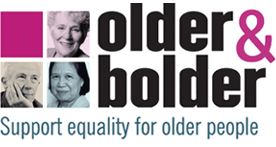Older & Bolder closed June 2013 This is an archived website
Major policy decisions could be made on questionable information
Older & Bolder says major policy decisions could be made on the future of the State Pension and income supports based on questionable information.
A research paper, Measured or Missed? Poverty and Deprivation among Older People in a Changing Ireland, presented today raises questions about how poverty and deprivation are being measured among older people in Ireland. The research was prepared for Older & Bolder by Professor Mary Daly of Queen’s University, Belfast and was presented today at a meeting in Dublin.
Patricia Conboy, Older & Bolder’s Project Director, said that her alliance is very concerned that major policy decisions could be made shortly by Government – for example on the future of the State Pension and other income supports – based on questionable information on the levels of poverty and deprivation among older people.
At the presentation of the research, Professor Mary Daly said that a key finding from her research concerns the complexity of how poverty is measured in Ireland and the effectiveness of the measures at picking up the situation of older people. In this context, Professor Daly explained that there are two primary measures of poverty and deprivation among the Irish population as a whole – the relative poverty measure and the consistent poverty measure.
“The relative poverty measure shows that 84% of older people aged 65 to 74 years and 89% of those aged 75 years and over are at risk of poverty, before receiving social transfers, i.e. the State Pension and other State allowances. This compares with a consistent poverty rate of 1.7% among people aged 65 to 74 and 1% among those aged 75 and over. The low level of consistent poverty seems anomalous, given the high dependence of older people in Ireland on the State Pension and other supports for the major portion of their income.”
Professor Mary Daly’s research pointed out that the way in which poverty is measured in Ireland makes no adjustments for levels of healthiness or disability which are very pertinent for older people. Other questions raised about the Irish methodology for measuring poverty include:
• UK research shows that older people are less likely to say they cannot afford an item and more likely to say they don’t want it – research shows that these answers could be associated with issues of pride, dignity and different values;
• Older people’s consumption patterns are different to those of the rest of the population – some of what is deemed essential for younger people is not seen by older people to be so;
• The consistent poverty measure does not assess service deprivation – which is of significant importance to older people.
Professor Daly also highlighted the highlighted the volatility of statistics on poverty among older people.
“Poverty rates among older people shot up during the early years of the Celtic Tiger but in the last few years have come down considerably and are now actually below the average (the latest data available at the time of writing are for 2008). This volatility in poverty rates is itself a bit worrying from a measurement perspective. It is clear, though, that looking at the situation of older people vis-à-vis other sectors of the population, their heavy reliance on state pensions and social welfare generally to stay out of poverty is very striking. The fact that income poverty rates among older people have come down underlines the importance of a decent state pension as pensions play a key role in keeping older people out of poverty.”
Given the doubts about these indicators in assessing the level of poverty and deprivation among older people, Professor Daly called for a public debate on the subject and the development of programme of research on effective approaches to measuring poverty, deprivation and social exclusion among older people.
Speaking at the same presentation, Older & Bolder’s Patricia Conboy said that her alliance endorses Professor Daly’s analysis and recommendations.
“Ireland’s National Action Plan for Social Inclusion 2007 – 2016 presents a vision for the inclusion of older people. This vision looks to older people’s full participation in civic and social life; access to adequate income; support for independent living in their own homes in old age; and access to health and social care services. Critical elements of this vision for inclusion are clearly missed in our existing approaches to poverty measurement and social exclusion among older people.
“In Older & Bolder’s view, there is a manifest need for a better match between national policy on social inclusion and national policy and practice on measurement of poverty and social inclusion. In the absence of such a match, we are concerned that major policy decisions could be made shortly by Government – for example on the future of the State Pension and other income supports for older people – based on questionable information on the levels of poverty and deprivation among older people,” Patricia Conboy concluded.







